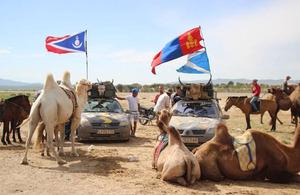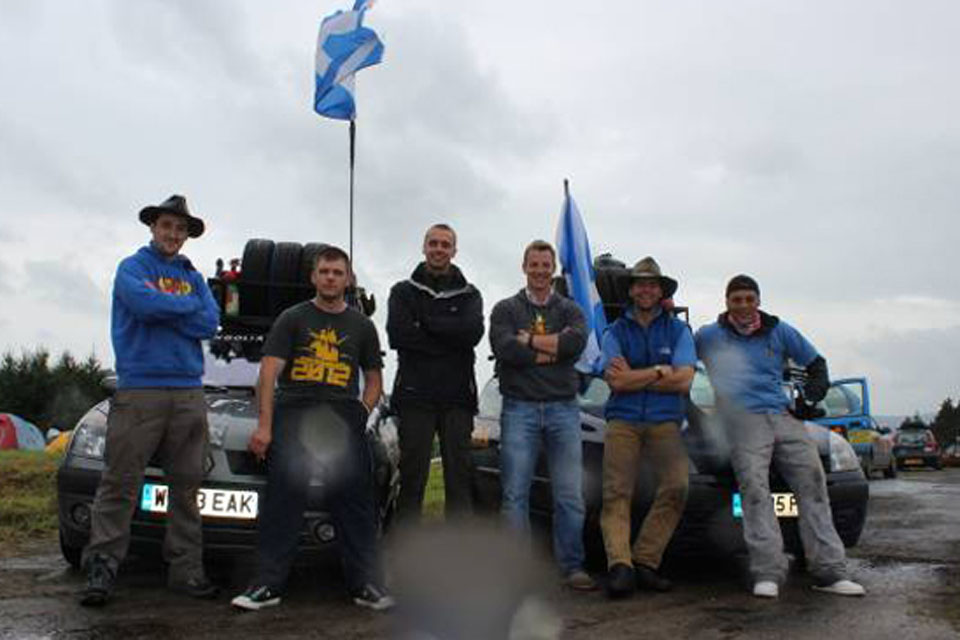Scots Dragoon Guards take on Exercise Mongol Eagle
A group of soldiers from the Royal Scots Dragoon Guards (SCOTS DG) have successfully completed the demanding and challenging Mongol Rally.

Camel traders, Gobi Desert [Picture: via MOD]
The race, which the personnel referred to as Exercise Mongol Eagle, started in Goodwood, Sussex, traversed countries including Ukraine, Russia and Kazakhstan, and finished 10,000 miles (16,000km) later in Ulaanbaatar, Mongolia.
The only rules are that racing vehicles must be either a car under 1200cc, a Service vehicle (eg fire engine), or a motorcycle under 125cc.
The route is up to the team and the timeframe is four to seven weeks.
Although Service personnel have participated previously, the recent addition of motorsports to the approved list of Army sports gave the SCOTS DG soldiers the catalyst to enter the race as an authorised team.
The SCOTS DG soldiers - ‘The Screaming Eagles’ - completed the race in 27 days and came 30th out of 309 teams.
Here, Exercise leader Major Nick Foulerton recalls the team’s epic journey.
In torrential rain the flag finally went down on the starting grid on the legendary Goodwood motor circuit. We began a gruelling journey that would hopefully see us drive a third of the way around the planet, in cars that were designed to provide grannies with transport to the supermarket.
Our two steeds were ten-year-old Renault Clios (Papa and Nicole) and from the concerned comments of other teams, there was little chance of ‘the most unreliable car in the world’ ever making it across the wilds of Central Asia. How wrong they were.
At the second corner of the track we passed a Danish team picking up their gearbox (308 teams remaining) and on the road to Chichester we passed a white, fur covered VW Golf in the hedge with two girls in bunny outfits assessing their chances (307 teams remaining). Things were looking more hopeful.

The team in the Czech Republic. Left to right: Troopers Gemmell and Kendrick, Corporal Munro, Captain Irwin, Major Foulerton, Lance Corporal Stewart [Picture: via MOD]
After a wet journey across Europe (We drilled the luggage racks straight into the roof and forgot to seal the holes) we arrived at Klendova Castle in western Czech Republic, just in time for the ‘Czech Out’ party; a final send off before heading into bandit country.
We travelled east through the beautiful Bohemian countryside, entering the Ukraine in the wood covered Carpathian Mountains. As a farmer I find the Ukraine an interesting country; however, 1,000 miles (1,600km) of wheat fields did get a little monotonous.
We were taking a relatively direct route to Mongolia and time pressure meant that we spent 12 - 14 hours a day in the car.
After crossing into Russia we spent a day in Volgograd (Stalingrad) visiting the monumental Mother Russia statue and grave of the Unknown Warrior. Both of these are built on a hill which saw some of the fiercest fighting in WWII. We followed the mighty Volga south to Caspian Sea where we bathed and almost certainly attained uranium poisoning, before crossing another border.
The sheer size of Kazakhstan can be demonstrated by the fact that at the point we crossed into it, Calais was closer that the point than we would exit the country, many thousands of miles to our east.
Kazakhstan has received a mixed fallout from the Soviet Union. It has some of the largest oil and gas reserves in the world, but some of the worst environment degradation; the Aral Sea, the Polygon (Ex Soviet nuclear testing ground) are just some of the better known examples.
The next 2,000 miles (3,200km) saw our poor Renaults take hits that felt like IED strikes as we negotiated the pot holes. One team destroyed 12 wheels in the Kazakh crossing. In a similar way to the Ukraine, the countryside was not the most inspiring; miles of steppe marked occasionally with Soviet era industrial detritus, spewing filthy smoke.
We had kindly been offered a place to stay at the US Embassy and we could not have been better hosted. That evening we were invited to the British Embassy’s Olympic Opening Ceremony party at the swankiest hotel in town. Ale, Yorkshire pudding and scones were a strange contrast to their surroundings.
With sore heads we proceeded to the Russian border where we met to other rally cars, our first sighting since the Czech Republic. Entering Russia was something of a relief after the enormity of Kazakhstan and being in Siberia finally felt as though we had broken the back of the journey. We headed south into the magnificent Altai Mountains.
Kazakhstan has built itself Las Vegas style capital from scratch in the centre of the endless steppe, using the most contemporary architecture. It is difficult to believe that there was hardly anything there 15 years ago.
Finally, on 30 August, we entered Mongolia at a remote check point. As we processed our car at customs we were pleased to hear that out of 309 teams, we were the seventh to cross the border. The guards were busy watching the Olympics where Mongolia was competing against Britain in archery. When asked if we would be able to cross today, the answer was clear; ‘If Mongolia win; yes. If Britain win; no!’.
Mongolia was to be the highlight of the trip and of all the places I have visited, the limitless horizon and the almost absence of mankind made it unique. Although Mongolia is very much on the rise, economically the nomadic tradition runs deep and as a people they are clearly at their happiest, wandering the endless steppe.
Our route took us through the south of the country, where we were sandwiched between lush valleys and the dunes of the Gobi desert. With the majority of the 1,700 kilometres that we had to cover, not resembling anything close to a road, it was no surprise that it took ten days, at an average speed of 14 mph (22.5km/h).
We made our way over the passes of the Altai Mountains, with the company of two hitch hikers and a pair of Yak heads atop of the cars. Our first night saw us camping beside a beautiful mountain lake, which was the scene of one of the last battles between the Red Army and the White Russians.
Navigating was difficult without any roads and dozens of tracks leading in different directions. The route ping ponged between white Gers (Yurts) sprinkled sparingly across the landscape, where a lot of pointing, smiles and vodka would see us off, hopefully in the right direction.
As I have experienced before, it is those that have the least, that give the most to the weary traveller and here was no exception. In a place as remote as this, every traveller has a duty to stop, and we helped and were helped every day.
We had a little time to spare so we headed north to Genghis Khan’s capital; Karakoram. At the heart of the largest empire the world has ever seen, one might expect a magnificent capital, but not in Mongolia. Just more tents.
After the Mongols ransacked and conquered most of the known and unknown world, they quietly retired to their nomadic ways on the high steppe of Asia.
At 1130hrs on Friday 10 August two rather battered Renault Clios crossed the finish line, 10,000 miles and 27 days after crossing the start line at Glorious Goodwood.
Commanding Officer of 7th Armoured Brigade (Desert Rats), Brigadier Paul Nanson, said of the achievement:
An outstanding adventure and a very comprehensive Recce Report! This is exactly the type of opportunity we should be searching for to keep our soldiers engaged. I realise just how much hard work must have gone into the planning for such an undertaking - testament to you and the team.
General Officer Commanding 1st (UK) Armoured Divison, Major General James Bashall, concurred:
This is fantastic. You have my highest admiration for organising and leading such a fantastic sporting event. I absolutely agree this is an activity we should encourage. I am certain all those who took part will be better people, and better soldiers, for the experience.
A rally of this nature offers soldiers something completely different from the sports field. The very challenge of getting such a car across the wilds of Mongolia is just the start.
This race across Asia traversed a third of the way around the planet in less than a month, across some of the most isolated regions on earth and required the team to be completely self-sufficient.
It is for these reasons that the 2012 Mongol Rally gave these soldiers a challenge that Army sport should deliver.